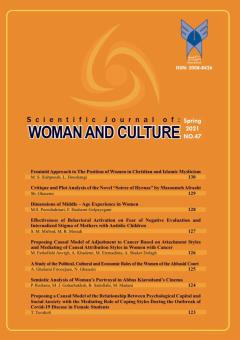Semiotic Analysis of Woman's Portrayal in Abbas Kiarostami's Cinema
Subject Areas : Art and ArchitecturePedram Rostami 1 , Mohammad Javad Goharbakhsh 2 , Babak Sadollahi 3 , Mojtaba Madani 4
1 - Art University in Tehran, Department of Cinema, Tehran, Iran.
2 - Art University in Tehran, Department of Cinema, Tehran, Iran.
3 - Art University in Tehran, Department of Cinema, Tehran, Iran.
4 - Art University in Tehran, Department of Cinema, Tehran, Iran.
Keywords: representation, woman's portrayal, Abbas Kiarostami,
Abstract :
The objective of this study was to scrutinize the semiotics of the image of women in Kiarostami's cinema. The statistical population was Kiarostami's films focusing on women's semiotics. Purposive sampling method was adopted and the films "Report" and "Ten" were the samples of the research. The research design was descriptive-analytical. The data was obtained through library resources and watching films. The films were analyzed from semiotics point of view. The implemented semiotics was based on the two major traditions of Ferdinand de Saussure and Charles Sanders Pierce. The study of Kiarostami's feature films indicated that he was cognizant on women and their concerns during his career and devoted much of his late filmmaking career to represent women and their problems. Notably in his recent works, he spotlighted women in his films. The results of the semiotic study of "Report" and "Ten" showed that Kiarostami tried not only to reflect the problems of women, but also to depict the society's attitude and expectations toward them, and emphasized that such traditional and stereotypical view, despite the passage of years, still existed in the society.
- ادمز، لاری اشنایدر. (1996). درآمدی بر روششناسی هنر. ترجمه شهریار وقفیپور. (1395). تهران: مینوی خرد.
- جمشیدی، اکرم، اسفندیاری، شهاب، بنی اردلان، اسماعیل. (1396). تحلیل تقابل سکون / حرکت در سینمای عباس کیارستمی بر مبنای نظریۀ زیباییشناسی سکون لورا مالوی. هنرهای نمایشی و موسیقی (هنرهای زیبا)، 24(1)، 86-79.
- چندلر، دانیل. (1952). مبانی نشانه شناسی. ترجمه مهدی پارسا. (1386). تهران: پژوهشگاه فرهنگ و هنر اسلامی.
- حسینی، سیدعماد. (1397). سینمایی دیگر. تهران: خانه هنرمندان.
- راودراد، اعظم، میرزاده طرقی، احسان (1396). نشانه شناسی تصویر زن در سینمای اصغر فرهادی (تحلیل نشانه شناسانه فیلم های سینمایی رقص در غبار، درباره الی و گذشته). جامعه شناسی هنر و ادبیات، 9(1)، 77-53.
- راودراد، اعظم، صدیقی خویدکی، ملکه. (1385). تصویر زن در آثار سینمایی رخشان بنی اعتماد. فصلنامهانجمن ایرانی مطالعاتفرهنگی و ارتباطات، 2(6)، ۳۱-۵۹.
- سلطانی گردفرامرزی، مهدی. (1386). زنان در سینمای ایران. نشریه هنرهای زیبا، 18(18)، 98-87.
- صمیم، رضا، آقابابایی، احسان، قاسمی، وحید. (1387). بررسی نقش و پایگاه اجتماعی زن و مرد در فیلمهای دهه هفتاد سینمای ایران. نشریه هنرهای زیبا، 35، 125-134.
- هیوارد، سوزان. (2006). مفاهیم کلیدی در مطالعات سینمایی. ترجمه فتاح محمدی. (1393). تهران: هزاره سوم.
- وایت، پاتریشیا. (1998). فمینیسم و فیلم. رویکردهای انتقادی در مطالعات فیلم. ترجمه علی عامریمهابادی. (1396)، تهران: انتشارات سوره مهر.
- Antić, M. (2016). Feminst Iranian Cinema: The Counter-Cinema of Abbas Kiarostami and Female Spectatorship. Genero: časopis za feminističku teoriju i studije kulture, 20, 31-51.
- Elena, A. (2005). The Cinema of Abbas Kiarostami, trans. London:SAQI/Iran Heritage Foundation.
- Haskell, M. (2016). From reverence to rape: The treatment of women in the movies. United states:University of Chicago Press.
- Bordwell, D.(2009). The movie looks back at us. David Bordwell's Website on Cinema. Retrieved from http://www.davidbordwell.net/blog/2009/04/01/the-movie-looks-back-at-us.
_||_

